Bennemann K.H., Ketterson J.B. Superconductivity: Volume 1: Conventional and Unconventional Superconductors; Volume 2: Novel Superconductors
Подождите немного. Документ загружается.

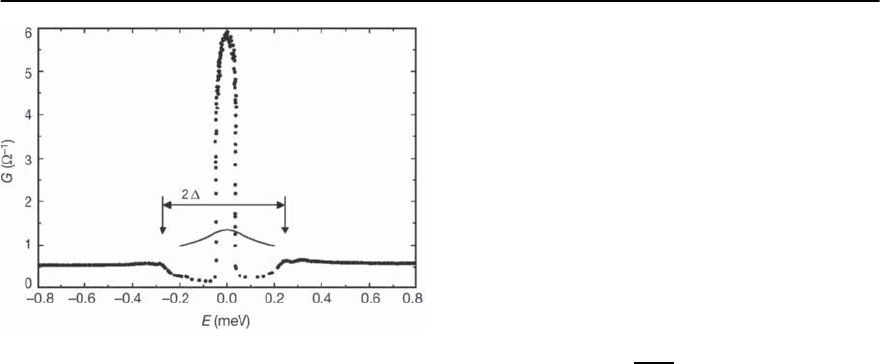
1120 P.S. Riseborough,G.M. Schmiedeshoff,and J.L.Smith
Fig. 19.65. The differential conductivity of a UBe
13
-Au point
contact at T = 330 mK, as a function of voltage. The height
of the zero-bias anomaly is roughly five times greater than
is expected for an s-wave superconductor. The solid line
shows an estimate of the Kondo contribution to G(V).[Af-
ter W¨alti et al. [444]]
In contrast to the very small magnitude of the zero
bias conductance peak found in UPt
3
and URu
2
Si
2
,
the magnitude of the conductance peak in UBe
13
[444] is roughly a factor of 5 times larger than the
theoretical value for an s-wave superconductor.The
enhancement of thezero bias anomaly was attributed
to the formation of an Andreev surface state, which
can occur if there is a non-trivial dependence on the
angle subtended by the nodes of the order parameter
to the normal to the interface [445]. As the bias volt-
age was increased, the zero bias conductance peak
of UBe
13
was followed by a minimum which was re-
duced from the normal state value and then showed
a sharp increase as it recovered to the normal state
value. The variation of the differential conductivity
withvoltageis shownin Fig.19.65.Thesharpincrease
occurred at a temperature-dependent voltage which
was of the order of magnitude 0.25 mV at 330 mK.
Such sharp changes of the conductance havenot been
observed for s-wave superconductors but have been
predicted to occur at the gap voltage eV =
0
for
junctions with anisotropic superconductors [445].If
the temperature dependent characteristic voltage is
interpreted as being the magnitude of the order pa-
rameter
0
(T), then UBe
13
wouldcorrespondtoa
universal ratio 2
0
(0)/k
B
T
c
of about 6.7 which is far
greater than the BCS value of 3.5, and is also greater
than the ratio predicted for most p-wave phases
(ABM 4.6,polar 4.9) butis more comparable with the
value of 6.2 predicted for the m =0d-wave phase.
Josephson Tunneling
Josephson tunneling involves the tunneling of
Cooper pairs between two superconductors [446].A
d.c.tunnel current may appear even in the absence of
an applied voltage but also appears as an a.c. current
if a voltage is applied. The a.c. current is expressed
in terms of the phase difference between the wave
functions of the two superconductors
I(t)=I
0
sin
2eVt
+ '
. (19.239)
The phase difference not only has contributions from
the intrinsic phases of the superconductors but also
has contributions from any magnetic vector poten-
tial that may be present at the junction.When inte-
gratedover the finitesizeof the contact,this term can
give rise to a Frauenhofer diffraction pattern [447].
The leading order contribution to the Josephson cou-
pling can be calculated using second order perturba-
tion theory [446]. To lowest order there should be
no Josephson current between a singlet and triplet
superconductor [448], since spin is conserved in the
tunneling process.However,even in this case,spinor-
bit interaction and higher order processes may pro-
duce a non-zero Josephson current. If the tunneling
is due to a fourth order process, the Josephson fre-
quency is expected to be given by 4eV/h.Sincethe
presence of the surface locally violates certain rota-
tional symmetries contained in the point group, it
is possible for relatively large Josephson currents to
flow between superconductors with different orbital
symmetries. In fact, the magnitude of the order pa-
rameter at the surface may even vary with the relative
orientation of the boundary and the node directions.
Due to this, it is possible to extract the symmetry of
the order parameter from Josephson tunneling mea-
surements [449]. However, the Josephson effect is a
very weak effect and sensitive to impurities and in-
homogeneities, since the total coupling energy for a
conventional Josephson junction is estimated to be
only of the order of 1 eV. For the heavy-fermion sys-
tems, the preparation and characterization of good

19 Heavy-Fermion Superconductivity 1121
surfaces and junctions represent formidable experi-
mental problems.Therefore, there has been only lim-
ited progress in the investigation of the Josephson
effect in heavy-fermion superconductors.
A d.c. Josephson current was found to exist be-
tween CeCu
2
Si
2
and Al [438]. The Josephson current
vanished at the T
c
of CeCu
2
Si
2
with applied mag-
netic fields greater than the upper critical field of Al
but smaller than the critical field of CeCu
2
Si
2
.Hence,
the tunneling current involved the superconducting
phases of both materials. The application of mag-
netic fields produced irregular Frauenhofer diffrac-
tion patterns which were smeared out. The smearing
was attributed to the irregular geometry of the junc-
tions. As the observed value of the critical current
was quite large, having a maximum magnitude that
is 80% of the BCS value, it appears as if the Josephson
coupling is of second order [450] and not of fourth
order. Furthermore, sinceAl is known to be a singlet
superconductor,thelarge coupling strength indicates
that CeCu
2
Si
2
is also a singlet superconductor.
No Josephson currents were found to flow across
weak links between UPt
3
surfaces [438]. However,
a Josephson current, with an irregular Frauenhofer
pattern and well defined Shapiro steps was observed
between UPt
3
and Nb in a superconductor–normal
metal–superconductor junction [451]. The critical
current measured for junctions where the current
flow is primarily along the c -axis of the UPt
3
single
crystal is significantly largerthan for junctionswhere
the current flows along the basal plane. The critical
current temperature relations show clear kinks at the
lower critical temperature T
c2
. For temperatures be-
low T
c2
, the slope of the critical current-temperature
relation is large for current flow along the c direc-
tion, and smaller for current flow in the basal plane.
For temperatures above T
c2
, the slope of the criti-
cal current temperature relation for flow in the basal
plane changes to a larger value but the curve rep-
resenting flow along the c-axisisratherflat.The
change in the anisotropy at T
c2
seems to indicate
that the anisotropy in the current flow is related to
the unconventional nature of the superconductivity
in UPt
3
. It should be noted that, since the anisotropy
measurements were made on junctions with different
surfaces, the apparent anisotropy possibly could re-
flect a difference in the properties of the interfaces.A
much larger anisotropy was inferred from measure-
ments of Josephson currents through point contacts
between URu
2
Si
2
and Nb [452] where no current was
observed for contacts aligned parallel to the c-axis
but finite currents were found for contacts aligned
parallel to the a–b directions. The absence of Joseph-
son currents flowing along the c-axis could, however,
have many other possible causes.
No Josephson tunneling currents were observed
to flow across a weak link between two surfaces of
UBe
13
. In a junction between Al and UBe
13
,super-
conductivitywas introducedinUBe
13
by the proxim-
ity effect for temperatures below the superconduct-
ing transition of Al but above the superconducting
transition for UBe
13
. In this temperature regime, a
weak Josephson current was observed between these
materials. A proximity induced Josephson current
was also found to occur across a point contact be-
tween UBe
13
and Ta at temperatures below T
c
for
Ta and ab ove T
c
for UBe
13
. This Josephson current
was destroyed as the temperature was lowered be-
low the T
c
of UBe
13
[453, 454]. This was taken as
evidence that the superconducting order parameter
of UBe
13
competes with the superconductivity of Ta
and hence, are of different symmetry. The analysis
presented in [454] suggested that the Cooper pairs
were spin-triplet, however, spin-singlet d-wave pair-
ing would be more consistent with the experimental
observations. In particular, when illuminated with
microwave radiation of frequency !,thecurrentd.c.
voltagerelationexhibitedShapiro stepsof magnitude
V = !/2e,insteadofV = !/4e as would be
expected for a fourth order Josephson coupling be-
tween singlet and triplet superconductors [448,455].
The interpretation of these experiments is enigmatic
since a conventional Josephson tunneling current,
with an irregular Frauenhofer pattern (see Figs.19.66
and 19.67) and conventional Shapiro steps (shown
in Fig. 19.68), was observed at temperatures below
0.94 K between UBe
13
and Nb in a fairly well defined
superconductor–normal-metal–superconductor ge-
ometry [456]. The Shapiro steps were observed to
have a magnitude of V = !/2e, as expected for
a second order Josephson coupling between two sin-
glet superconductors. On the other hand,the magni-
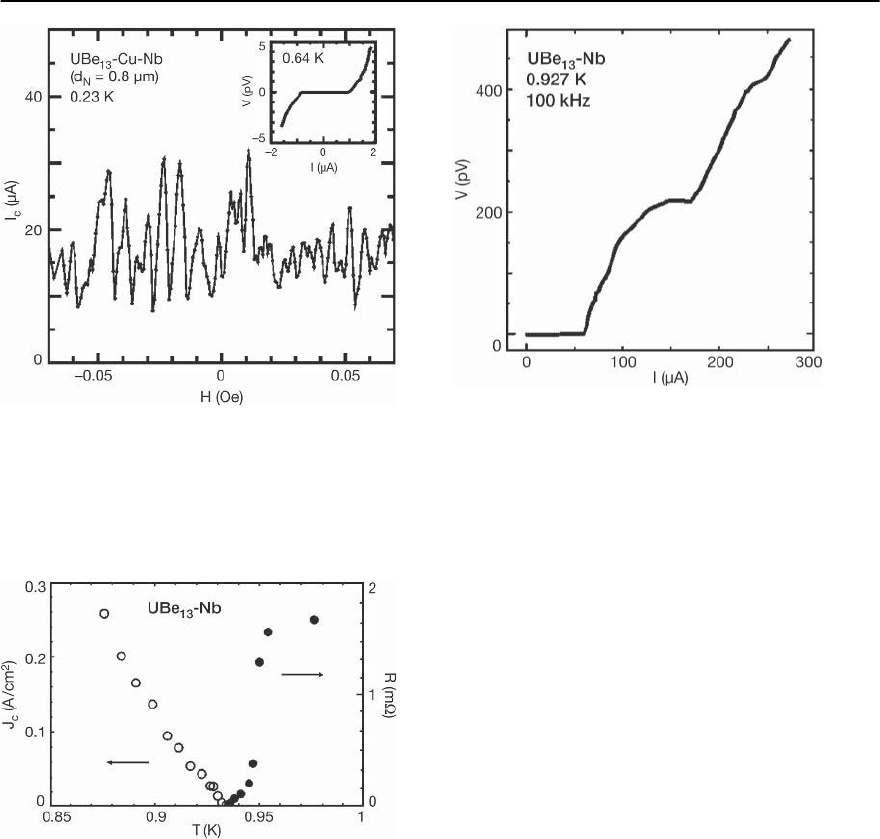
1122 P.S. Riseborough,G.M. Schmiedeshoff,and J.L.Smith
Fig. 19.66. The field dependence of the Josephson current
through a UBe
13
-Cu-Nb junction.The irregular Frauenhof-
fer pattern suggests that the junction is not uniform. The
inset shows the I − V curve showing the critical Josephson
current. [After Shibata et al. [456]]
Fig. 19.67. The temperature dependence of the critical
Josephson current J
c
and the junction resistance R,near
T
c
for a UBe
13
-Nb junction.After Shibata et al. [456]
tudes of the critical currents were remarkably small,
being two orders ofmagnitude smallerthan thecriti-
cal currentsobservedin UPt
3
.However,as the critical
currents were limited by heating, it was not possible
to determine whether the magnitude of the Joseph-
son coupling in UBe
13
was consistent with the tun-
neling being due to a fourthorderprocessor a second
order process.
Fig. 19.68. The I(V)relationforaUBe
13
-Nb junction,show-
ing conventional Shapiro steps when an ac current of fre-
quency 100 kHz is superimposed on the dc current. [After
Shibata et al. [456]]
19.4.3 Dynamic Magnetic P roperties
Nuclear Magnetic Resonance
As previously mentioned, nuclear magnetic reso-
nance experiments yield several important quanti-
ties: the Knight shift and the nuclear spin relaxation
rates which are 1/T
1
the longitudinal relaxation rate,
and the transverse relaxation rate 1/T
2
.Thechanges
in behaviorof these quantitiesonentering the super-
conducting phase does give information about the
nature of the density of magnetic excitations in the
superconductor.
The Knight Shift
The Knight shift has many contributions, one im-
portant contribution provides a measure of the lo-
cal part of the static susceptibility of the itinerant
electrons which produces a magnetic polarization
at the nuclear site. For heavy-fermion superconduc-
tors, the normal state Knight shift is expected to be
dominated by the enhanced Pauli spin susceptibil-
ity, though spin-orbit coupling will introduce an or-
bital part. However, in the superconducting state,the
Knight shift is expected to be dominated by the dia-
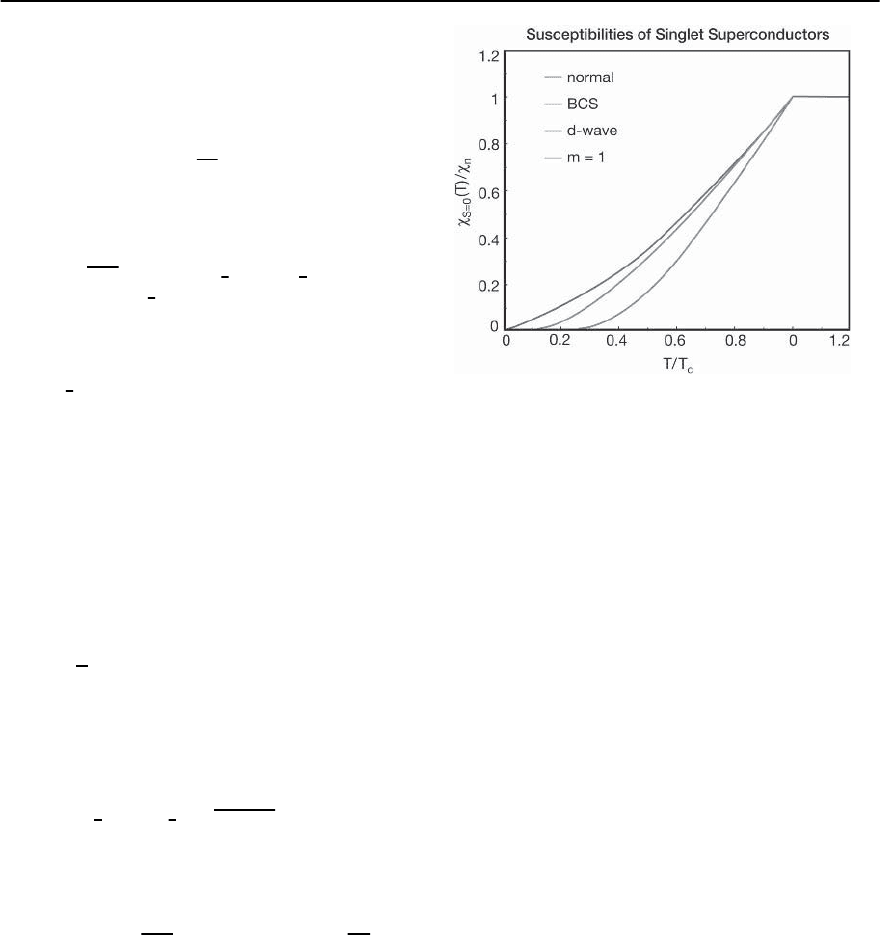
19 Heavy-Fermion Superconductivity 1123
magnetic susceptibility produced by the supercur-
rent shielding the external field. The Pauli spin sus-
ceptibilitywill be modified by the superconductivity,
and provide informationabout the pairing.The zero
field susceptibility is defined as a derivative of the
magnetization (T)=(
∂M
∂H
). The magnetization that
is produced by the electronic spins aligning with a
magnetic field applied along the z-axis is given by
M
z
=
g
B
2
k
f (E
↑,k
)−f (E
↓,k
)
, (19.240)
whichisexpressedin termsof the Fermi-distribution
for quasi-particles with spin and quasi-particle en-
ergy E
,k
. The field dependence of the quasi-particle
energies depends on the type of spin pairing, so we
shall discuss the different types of spin pairings sep-
arately.
Singlet Pairing
For singlet pairing, the magnetic field couples to the
spins of the quasi-particles via the Zeeman ener-
gies. As can be seen from inspection of the matrix
in Eq. (19.58), only the time reversal partners pair
when
−→
d (k
) ≡ 0. The quasi-particles consist of bro-
ken pairs, i.e., electrons of spin and holes of spin
−. Since a down-spin hole has the same Zeeman
energy as an up-spin electron, the quasi-particle en-
ergies depend on the magnetic field through
E
,k
= E
H=0,k
−
g
B
H
2
(19.241)
and so the spin susceptibility takes the usual form
S=0
(T)=4
g
B
2
2
∞
0
dE
S=0
(E)
−
∂f
∂E
.
(19.242)
The BCS density of states should be used in the
above expression, for an s-wave superconductor. In
this case, the susceptibility tends to zero as T →
0 in an exponentially activated way
BCS
(T) ∼
exp[−
0
/k
B
T].The exponential vanishing of the spin
susceptibility occurs as the electrons form singlet
Fig. 19.69. The calculated spin susceptibilities of singlet
superconducting phases. The susceptibilities are normal-
ized to the normals state susceptibility. The susceptibil-
ities in the singlet superconducting phases all vanish as
T → 0. The susceptibility of the BCS phase is given by the
Yosida function, which vanishes exponentially at low tem-
peratures. The susceptibilities of the isotropic and m =1
d-wavephasesvaryaspowersofthetemperature,atlow
temperatures
pairs in the ground state,and the finite spin moment
is caused by thermal population of quasi-particles
[457]. For a singlet superconductor that has point
nodes, the density of states varies as E
2
at low ener-
gies and, therefore, one expects that
S=0
(T) ∝ T
2
for T T
c
. Whereas for a singlet superconduc-
tor which has line nodes, the density of states is
given by
S=0
(E) ∝ E at low energies, hence one ob-
tains
S=0
(T) ∝ T. The temperature dependence of
the calculated spin susceptibility expected for vari-
ous singlet spin superconducting phases is shown in
Fig. 19.69.
Thus, in the spin singlet phases, the spin suscep-
tibility could be expected to vanish as T → 0. How-
ever, spin-orbit coupling will produce a residual sus-
ceptibility that depends on the ratio of the super-
conducting coherence length,
0
,tothemeanfree
path due to spinorbit scattering, l
so
. In the presence
of spin-orbit coupling, the spin is no longer a good
quantum number for the single-particle eigenstates
and the spin-up and spin-down states are mixed. In
the limit that the strength of the spin-orbit coupling
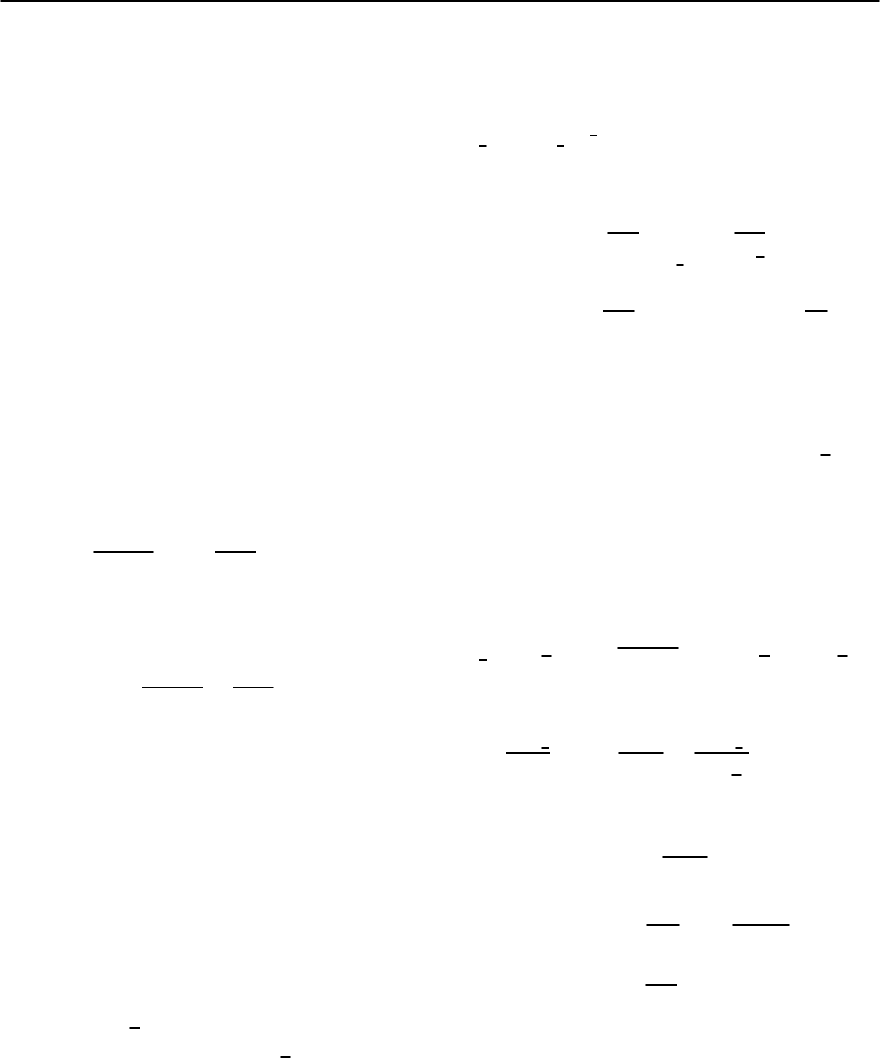
1124 P.S. Riseborough,G.M. Schmiedeshoff,and J.L.Smith
−→
L .
−→
S is so large that
0
, the average value
of
z
for a single particle state tends to zero. The
spin susceptibility is, therefore, reduced. From the
Kramers–Kronig relations, one observes that a sig-
nificant contribution to the normal state (T)comes
from single-particle states with excitation energies
of the order of the spin-orbit scattering rate /
so
which is,by assumption, greater than
0
.Asanopen-
ing up of a superconducting gap at the Fermi energy
is not expected to change the contribution of these
higher energy states, one finds that the susceptibility
in the superconducting state can remain comparable
in magnitude to the normal state value. According
to Anderson [458,459], the normalized susceptibil-
ity should have the two limits. The limit of strong
spin-orbit scattering is defined by l
so
0
,where
0
= v
F
/
0
and l
so
= v
F
so
, and the limit of weak
spin-orbit scattering is defined by l
so
0
.Inthe
limit of strong spinorbit scattering, the normalized
susceptibility is given by [460]
BCS
(0)
n
≈ 1−
8 l
so
3
0
. (19.243)
For weak spin-orbit scattering, the susceptibility ra-
tio is given by
BCS
(0)
n
≈
3
0
8l
so
. (19.244)
Hence, the existence of a partial Meissner effect at
T = 0 does not necessarily imply the presence of
either triplet or gapless superconducting phases.
Triplet Pairing
For triplet pairing,theabove argument indicates that
a finite susceptibility could be expected to arise due
to the S = 1 spin of the Cooper pairs. The way the
susceptibility depends on the orientation of the field
−→
H relative to the direction of
−→
d ,for a direction of
−→
d
independent of k
, is described below.
First,if
−→
d is parallel to
−→
H for all k
,then,as
−→
H is the
direction of quantization of ,
−→
d is parallel to ˆz and
so S
z
= 0. Since d
S
z
=0
is the only finite component of
the order parameter, the off-diagonal blocks in the
mean-field Hamiltonian Eq.(19.58) are proportional
to
x
.And so,asin the singlet case,only the same time
reversal partner states are coupled. Thus,one obtains
the same Zeeman type of couplingas the singlet case,
E
,k
= E
H=0,k
−
1
2
(g
B
H), and the susceptibility is
given by the same expression as Eq.(19.242) but with
the appropriate triplet density of states.
S=1,
(T)=2
g
B
2
2
k
−
∂f
∂E
k
(19.245)
=4
g
B
2
2
∞
0
dE
S=1
(E)
−
∂f
∂E
.
Hence, the spin susceptibility has a linear T varia-
tion for a density of states with lines of nodes or a T
2
variation with point nodes.
Second, if
−→
H is perpendicular to
−→
d for all k
,then,
as
−→
d is perpendicular to ˆz, the pairs are in a linear
combinationof states with S
z
= ±1.The off-diagonal
blocks of the mean-field Hamiltonian are of diago-
nal form andonly coupleelectrons andholes withthe
same spin directions. Then, the quasi-particle ener-
gies are given by
E
2
,k
=
e(k)− −
g
B
H
2
2
+
d
x
(k)+i d
y
(k)
2
.
(19.246)
Furthermore,since
∂E
,k
∂H
=−
g
B
2
∂E
,k
∂e
(k)
, (19.247)
the expression for
S=1,⊥
(T) has the form
S=1,⊥
(T)=
g
B
2
2
()
+∞
−∞
de
×
∂E
∂e
−
∂f (E
)
∂E
=2
g
B
2
2
() . (19.248)
Hence, in this case, the uniform static spin suscepti-
bility retains the normal state value. In general, for
triplet pairing, the orientational average of
S=1
(T)
will have a magnitude of 2/3 the normal state suscep-
tibility.
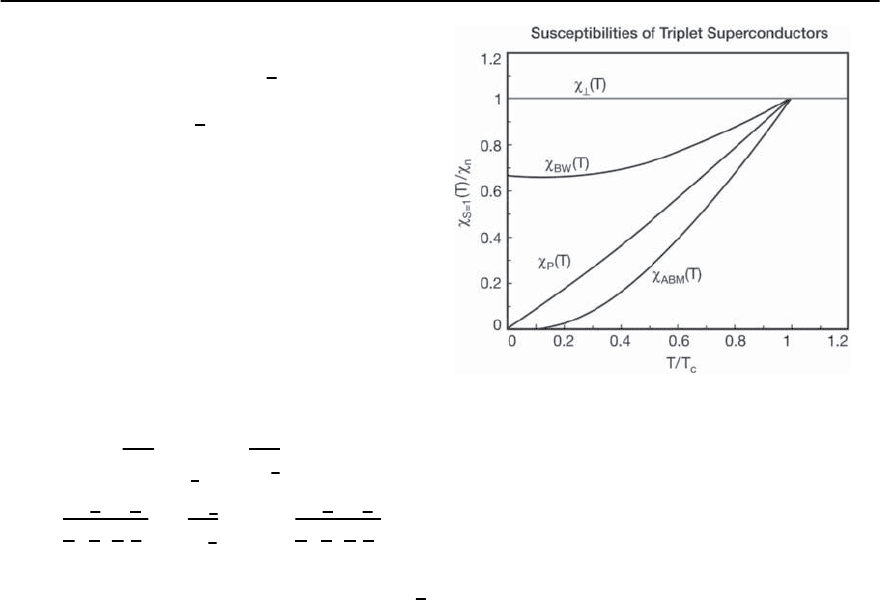
19 Heavy-Fermion Superconductivity 1125
The sum of the quasi-particleenergiesare lowered
when
−→
H is perpendicular to
−→
d (k
).Foranisotropic
system like
3
He, and a pairing vector which has a di-
rection independent of k
such as in the ABM phase,
the vector
−→
d will rotate to remain perpendicular to
the field and the susceptibility will remain constant.
On the other hand, heavy-fermion systems are ex-
pected to have strong spin-orbit coupling and crys-
talline anisotropy, therefore, the direction of
−→
d is
expected to remain constant when
−→
H is applied. If
the material has an anisotropy such that spins have
an easy axis or plane, then
S=1
for that phase will be
reduced if
−→
H tilts away from the axis or plane.In such
cases of strong anisotropy, the susceptibility tensor
is given by the directional average
i,j
S=1
(T)=2
g
B
2
2
k
−
∂f
∂E
k
(19.249)
×
d
∗
i
(k)d
j
(k)
d
∗
(k).d(k)
+
∂E
k
∂e
k
ı
i,j
−
d
∗
i
(k)d
j
(k)
d
∗
(k).d(k)
.
In the BW phase the zero temperature susceptibility
is 2/3 of the normal state value, this occurs as the k
averaged value of
−→
d
2
has one component parallel to
−→
H which is suppressed,the other two components re-
tain their normal values. The calculated spin suscep-
tibilities expected for various triplet superconduct-
ing phases is shown in Fig. 19.70. The above discus-
sion indicates that, if the behavior of the hyperfine
field is known (perhaps extrapolated from the nor-
mal state),the temperature dependence of the Knight
shift in the superconducting state can yield informa-
tion about the nature of the pairing.
In pure UBe
13
, the muon Knight shift [320] ex-
hibits a large reduction below T
c
with a magnitude
similar to that found in weak coupling s-wave su-
perconductors.The Knight shifts found for Th [320]
and B doped samples [461] show no appreciable
changes on entering the superconducting states
which is consistent with the formation of spin-
singlet Cooper pairs but with strong spin-orbit
scattering or gapless phases caused by impurity
scattering. The anisotropic Knight shift observed
in CeCu
2
Si
2
[462, 463] undergoes a significant re-
duction in the superconducting state, similar to the
Fig. 19.70. The calculated spin susceptibilities of triplet su-
perconducting phases. The susceptibility for the BW phase
is isotropic. The susceptibilities of the ABM and polar
phases are anisotropic, if the order parameter is pinned by
the lattice. The susceptibilities vanish at low temperatures
for applied fields which are parallel to the Cooper pair spin
but remain unaffected for fields oriented perpendicular to
the spin
behavior observed in UBe
13
. The reduction found in
CeCu
2
Si
2
is consistent with the vanishing of the spin
susceptibility at zero temperature, as expected for a
spin-singlet superconducting phase.In CeCoIn
5
[62],
the decrease of the
59
Co Knight shift in the supercon-
ducting state is large for fields along the c-axis and
is hardly noticeable for fields in the perpendicular
directions. However, the lack of any decrease in the
perpendicular directions was attributed to a large
temperature independent contribution to the sus-
ceptibility from the Co 3d orbitals. The observation
of a smaller but isotropicdecrease in the Knight shift
of
115
In below T
c
is supportive of a superconducting
state which involves spin-singlet Cooper pairs.
The Knight shift has been measured in the super-
conducting state of single crystals of UPt
3
[464,465].
For large fields [464], no appreciable change was ob-
served on entering the superconducting phase for
all directions of the applied field. However, a later
study [465] showed a very small decrease occurred
for fields aligned along either the b-axis or c-axis but
only forfields such that H
a
< 5kOeandH
c
< 2kOe.
This was interpreted as showing evidence for spin-
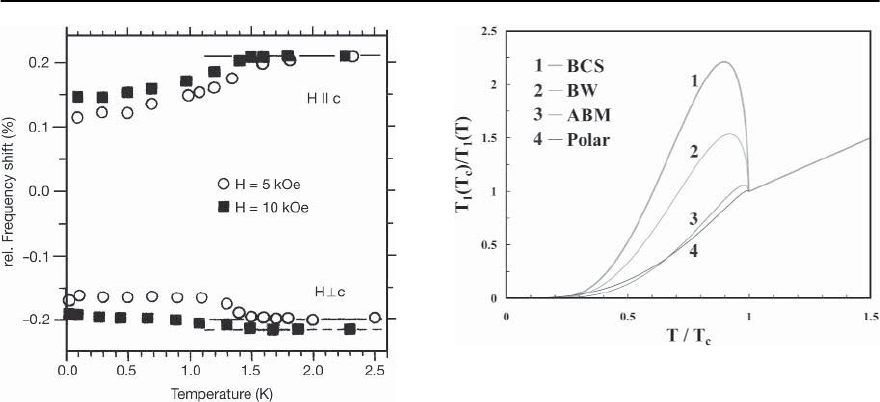
1126 P.S. Riseborough,G.M. Schmiedeshoff,and J.L.Smith
Fig. 19.71. Temperature dependence of the muon Knight
shifts in UPd
2
Al
3
, for fields applied parallel and perpen-
dicular to the c-axis. [After Feyerherm et al. [466]]
triplet pairing, in which the superconducting vector
order parameter is pinned to the lattice for small ap-
plied fields but for sufficiently large fields is free to
rotate so as to follow thedirection of theapplied field.
This explanation rests on the unjustified assumption
of very weak spin-orbit coupling in UPt
3
and also
does not explain the extremely small magnitude of
the change of Knight shift that occurs when the or-
der parameter is pinned. However, since the crystals
were of very high quality,the absence of a reduction
of the spin susceptibility at low temperatures is not
attributable to spin-orbitor to impurity scattering in
a spin-singlet superconducting phase.
Although the normal state susceptibility and the
SR Knight shift of UPd
2
Al
3
are anisotropic (see
Fig. 19.71), the small and anisotropic change in the
Knight shift which occurs below T
c
has been taken as
evidence that the electrons form spin-singlet Cooper
pairs. An analysis of the normal state data indicates
that part of the anisotropy originates in the cou-
pling. The dipole contribution is estimated to be
three times stronger than the hyperfine field cou-
pling. Although a small anisotropic change in the
Knight shift is observed as the temperature is de-
creased below T
c
, the analysis attributes the change
to an isotropic reduction of the f spin susceptibil-
Fig. 19.72. The calculated temperature dependence of the
spin-lattice relaxation rate 1/T
1
for the BCS, BW,ABM and
polar phases. The rates are normalized to the normal state
relaxation rate at T
c
. A Hebel–Slichter peak occurs below
T
c
for the BCS and BW phases, but is absent for the ABM
and polar phases
ity [466]. The reduction has a magnitude of 11%
which is only compatible with spin-singletpairing of
the quasi-particles if one partitions the f suscepti-
bility into separate quasi-particle and local moment
contributions. This is in direct contrast with con-
clusions from Al NMR Knight shift studies of the
isostructural compound UNi
2
Al
3
. The Knight shift
measurements of UNi
2
Al
3
have been interpreted as
indicating that the quasi-particles form triplet-spin
Cooper pairs [467]. Since the crystals are not axially
symmetric, the crystals contain two inequivalent Al
sites. As a consequence, the experiments on UNi
2
Al
3
show two distinct NMR peaks for magnetic fields
applied parallel to the a-axis. In UNi
2
Al
3
,theKnight
shift predominantly comes from the hyperfine cou-
pling which has a similar magnitude to that found
in UPd
2
Al
3
. However, on reducing T below T
c
,the
Knight shift observed for one peak did not show a
change comparable to that found in UPd
2
Al
3
and
hence, it is argued that these measurements provide
evidence for triplet-spin superconductivity. Due to
the much larger 1/T
1
contribution to the peak width
for fieldsalongthe c-axis,these experiments were un-
able to determine if the Knight shift exhibits the full
anisotropic Meissner behavior expected from a spin-
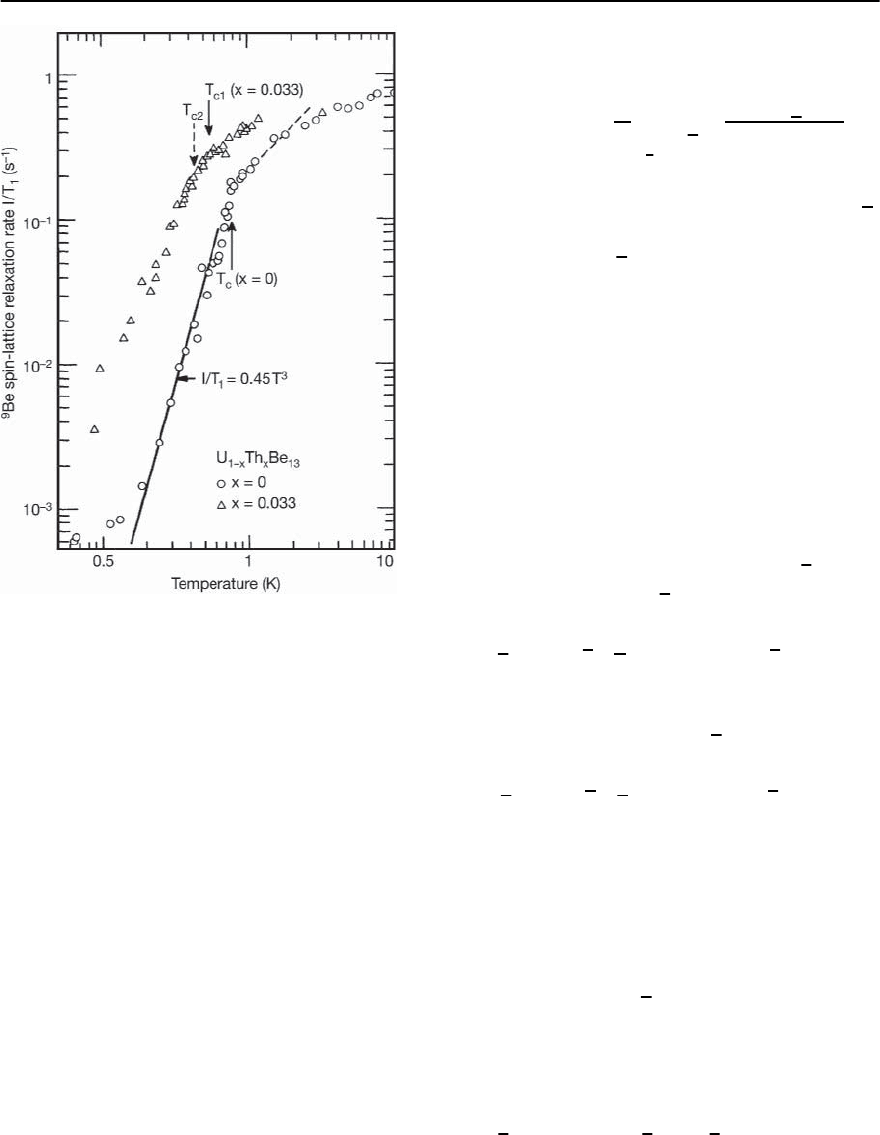
19 Heavy-Fermion Superconductivity 1127
Fig. 19.73. The temperature dependence of the
9
Be nuclear
spin relaxation rate 1/T
1
in U
1−x
Th
x
Be
13
,forx =0and
x =0.033. The solid line is a fit to a T
3
power law below T
c
,
and the dashed line is the normal state Korringa law.[After
MacLaughlin et al [25]]
triplet superconductor. Further results are shown in
Figs. 19.72 and 19.73.
Longitudinal Nuclear Spin Relaxation
The temperature variation of the Spin Lattice relax-
ation rate 1/T
1
can be drastically changed at the on-
set of superconductivity.Thisoccursasa result of the
change in the quasi-particle excitation spectrum but
alsoisduetoamodificationofthematrixelements
for the coupling of the quasi-particle excitations to
the nuclear spins. As the modification of the ma-
trix elements of the coupling interaction, known as
the coherence factor,involves the gap function,1/T
1
could provide additional information about the sym-
metry of the superconducting phase. The relaxation
rate for a spin distribution aligned along the z-axis
is driven byspin-flip fluctuations, andis given by the
expression
1/T
1
= k
B
T(g
B
)
2
1
N
q
A(q)
2
Im
+,−
(q; !
N
)
!
N
,
(19.250)
where !
N
is the nuclear Larmor frequency,and A(q)
is the averaged strength of the local hyperfine field.
The factor Im
+,−
(q; !) represents the density of
states for magnetic spin-flip fluctuations. A typical
valueofthenuclearLarmorfrequencyis!
N
∼ 10
−7
meV and so, for all but in systems with exceptionally
slow spin-fluctuations, one may approximate !
N
by
!
N
= 0. This approximation could be expected to
fail near a quantum critical point. Just to illustrate
the nature of the coupling to the superconductivity,
we shall replace the full susceptibility by the lowest
order polarization part or quasi-particle susceptibil-
ity.
The first step in evaluating the imaginary part of
the susceptibilityis to express the spin-flip operators
in terms of the four component fields ¦ (k
), so the
spin raising operator ˆ
+
(q)isgivenby
ˆ
+
(q)=¦
†
(−k − q)
+
0
0−
−
¦ (−k
) , (19.251)
where
+
and
−
are the 2 × 2 Pauli spin matrices.
The spin lowering operator ˆ
−
(q)isgivenby
ˆ
−
(q)=¦
†
(−k − q)
−
0
0−
+
¦ (−k
) . (19.252)
In general, the matrix ˜
i
corresponding to a spin
operator ˆ
i
is a 2 × 2 block diagonal matrix with
the upper and lower diagonal elements given,respec-
tively,by
i
and (i
y
)
i
(−i
y
), where the lower diag-
onal element reflects the effect of time reversal on
the spins. The lowest order contribution to the sus-
ceptibility tensor
˛,ˇ
(q; !) is expressed in terms of
the Fourier transform of the imaginary time single-
particle Green’s functions. These Green’s functions
are defined in terms of theWick’s time ordered prod-
uct of two four-component fields
G(k
; )=−< |
ˆ
T ¦ (k, )¦
†
(k, 0)| >. (19.253)
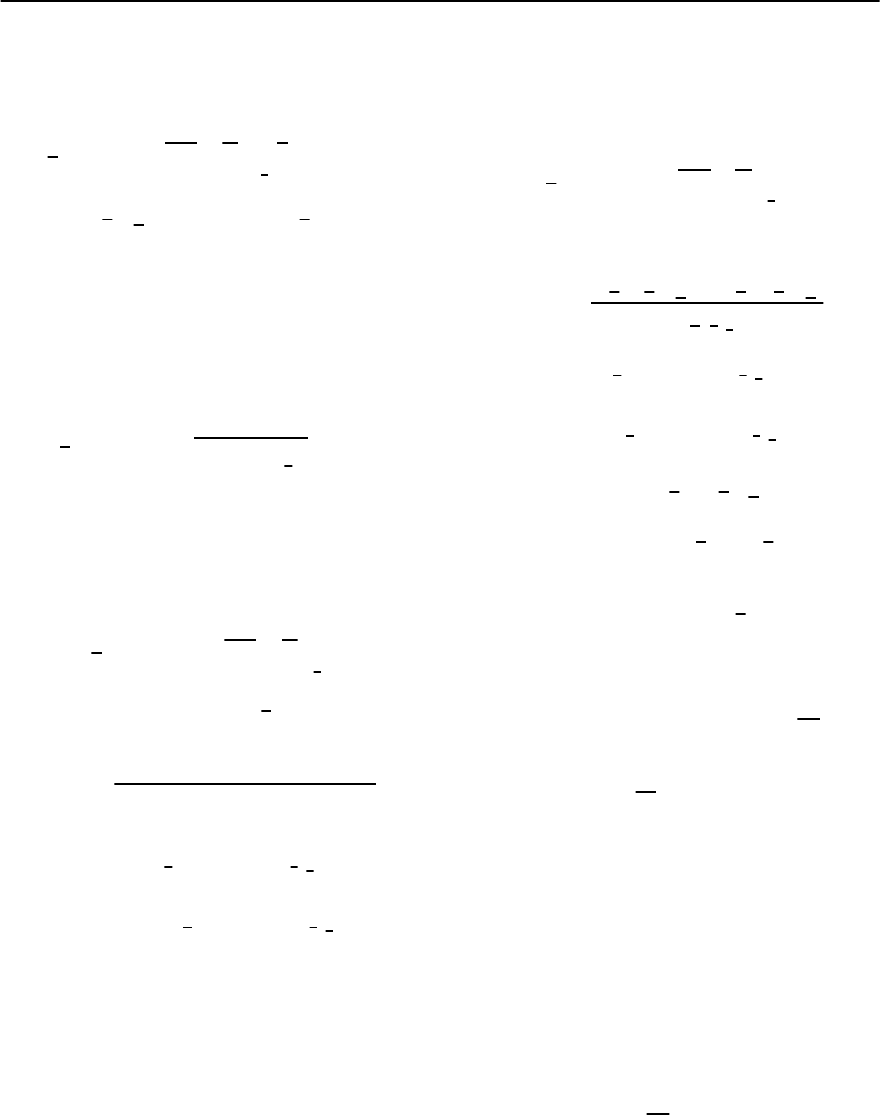
1128 P.S. Riseborough,G.M. Schmiedeshoff,and J.L.Smith
The susceptibility tensor can be written as the ana-
lytic continuation onto the real frequency axis of the
trace
˛,ˇ
(q;
m
)=k
B
T
g
B
2
2
1
N
n,k
1
2
trace
× G(k
+ q; i(!
n
+
m
)) ˜
ˇ
G(k; i!
n
) ˜
˛
,
(19.254)
where !
n
are the fermion Matsubara frequencies,
!
n
= k
B
T(2n +1)and
m
is a boson Matsubara
frequency. For unitary states where
˜
H
2
MF
is diagonal,
the quasi-particle contribution to the Fourier trans-
formed Green’s function can be written as
G(k
; i!
n
)=−Z
−1
(i!
n
+
˜
H
MF
)
2
!
2
n
+ E
2
k
. (19.255)
Hence,on evaluating Eq.(19.254) and continuing the
imaginary frequency i
m
onto the real ! axis,the en-
ergy difference components of the imaginary part of
the susceptibility tensor are given by the expression,
Im
˛,ˇ
(q; !)
= Z
−2
g
B
2
2
1
N
k
+∞
−∞
dE
×
f (E)−f (E + !)
1
2
trace
×
(E +
˜
H
MF
) ˜
ˇ
(E + ! +
˜
H
MF
) ˜
˛
4E(E + !)
×
ı(E − E
k
)ı(E + ! − E
k+q
)
+ ı(E + E
k
)ı(E + ! + E
k+q
)
.
(19.256)
This represents a quasi-elastic process involving
scattering from the thermal population of quasi-
particles.The factorsin front of the spinoperators,as
modified by the matrix nature of ˜ ,producetheco-
herencefactors.Thecoherence factorsdifferbetween
the singlet and triplet pairing cases.
Singlet Pairing
In this case, the spin-flip excitation spectrum is ob-
tained as
Im
+,−
(q; !)
= Z
−2
g
B
2
2
1
N
k
+∞
−∞
dE
×
f (E)−f (E + !)
×
1+
(k
)(k + q)+D(k)D(k + q)
E
k
E
k+q
×
ı(E − E
k
)ı(E + ! − E
k+q
)
+ ı(E + E
k
)ı(E + ! + E
k+q
)
. (19.257)
The two summations over k
and k + q in Eq.(19.250)
when combined with Eqn. (19.257) have the effect
that the bi-linear term in (k
)=e(k)−,which
is anti-symmetric about the Fermi energy, vanishes.
Also, since for singlet superconductivity, the order
parameter is an even function of k
these terms are
retained. Then, in the s-wave phase, the relaxation
rate is given by
/T
1
= k
B
TZ
−2
(g
B
)
2
A
2
∞
0
dE
−
∂f
∂E
×
1+
0
E
2
BCS
(E)
2
, (19.258)
wherewehaveset!
N
=0,andA is the local hy-
perfine field. The above expression indicates that a
peak in 1/T
1
should occur just at the superconduct-
ing transition.The peak occurs since the BCS density
of states diverges at E =
0
, which yields a diver-
gence in the integrand in the superconducting state.
The logarithmic divergence of 1/T
1
in the supercon-
ducting state is actually suppressed by small residual
anisotropy in the gap and also by the quasi-particle
lifetimes. As the derivative of the Fermi function
−
∂f
∂E
E=
0
(19.259)
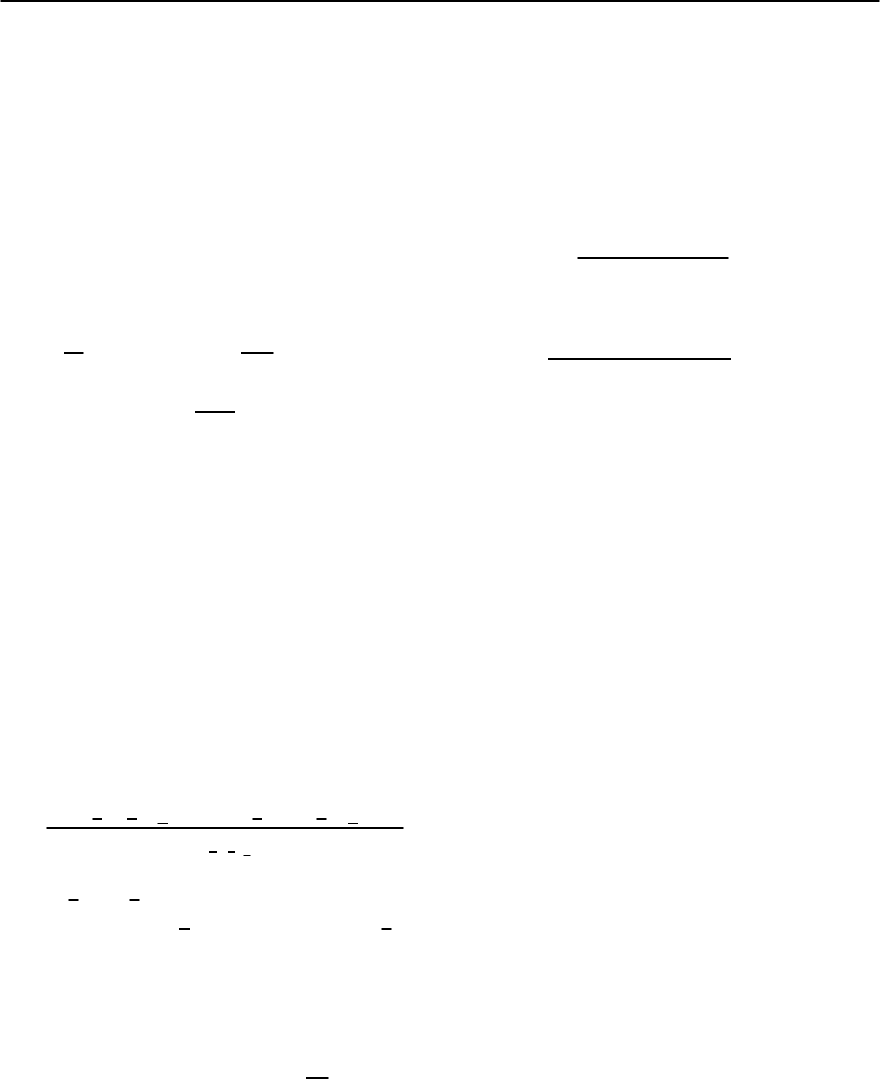
19 Heavy-Fermion Superconductivity 1129
has its largest value in the superconducting state at
T = T
c
, the above argument indicate that a peak
in 1/T
1
occurs just at T
c
. The resulting experimen-
tally observed peak is known as the Hebel–Slichter
peak [468], and is often seen in weak-coupling s-
wave superconductors. The peak actually occurs at
roughly 0.8 T
c
. This reduced temperature and the
suppression of the logarithmic divergence is well de-
scribed by interactions between thermally excited
phonons and the quasi-particles [469].Fibich found
that the temperature dependence of the rate could be
expressed as
T
1
∝ 2k
B
Tf (
0
)
1+
0
k
B
T
(1 − f (
0
))
× ln
2
2
0
(T)
4/3
, (19.260)
where (T) represents the imaginary part of the gap
which is a characteristic energy for quasi-particle
scattering from a thermal distribution of phonons,
(T) ∼ (k
B
T)
2
/!
D
. However, in strong-coupling
s-wave systems, quasi-particle interactions and life-
time effects can substantially suppress the peak. At
low temperatures, T T
c
, the relaxation rate is ex-
pected to show a thermally activated temperature
variation, 1/T
1
∝ exp[−
0
/k
B
T].
Triplet Pairing
Thecoherence factorsin thetripletor p-wave pairing
phases should be replaced by
1+
Re
(k
)(k + q)−(ˆz .
−→
d (k))(
−→
d
∗
(k + q) . ˆz)
E
k
E
k+q
.
(19.261)
Since (k
)=e(k)− is an odd function about the
Fermi energy and
−→
d (k
) is an odd function of k,the
bi-linear terms vanish, leaving a coherence factor of
unity. Hence, the rate is given in terms of an inte-
gration over an appropriate quasi-particle density of
states squared for the p-wave phase,
/T
1
= k
B
TZ
−2
(g
B
)
2
A
2
∞
0
dE
−
∂f
∂E
S=1
(E)
2
.
(19.262)
We note that the weak logarithmic divergence of the
density of states in the ABM phase is integrable, and
the Hebel–Slichter peak is also completely absent in
the polar phase.
At low temperatures in the BW phase, the same
type of exponentially activated behavior is recovered
as in the BCS phase. The low temperature form of
1/T
1
in the ABM phase is given by
/T
1
=4!
(g
B
)
2
A
2
Z
−2
()
2
4
0
(k
B
T)
5
(19.263)
and in the polar phase
/T
1
=
2
(g
B
)
2
A
2
Z
−2
()
2
2
2
0
(k
B
T)
3
, (19.264)
where the inequality T T
c
should hold for both
expressions. Thus, the characteristic energy depen-
denceassociated withthe distributionof nodes could
govern the low temperature quasi-particle contribu-
tion to the spin-latticerelaxationrate.Also,thequasi-
particle contribution to the relaxation rate should
remain unrenormalized.However,it should be noted
that only the lowest order polarization part of the
susceptibility has been considered but the higher or-
der interactions between the quasi-particles and ver-
tex correctionsarealso important.Thevertexcorrec-
tions may be expected to partially cancel the effect
of the self-energy which is responsible for Z.Thein-
teractions are responsible for adding the low-energy
collective spin-fluctuations to the continuum of sin-
gle quasi-particle Stoner excitations.
The spin-lattice relaxation rates of the heavy-
fermion superconductors UBe
13
[25], UPt
3
[470],
CeCu
2
Si
2
[472], UPd
2
Al
3
[471] and CeIrIn
5
[62,63]
do not show any evidence of a Hebel–Slichter peak at
T
c
, but instead show a cross-over between a linear T-
like Korringa variation above T
c
to an approximate
T
3
variation in the superconducting state. In UPt
3
,
the T
3
law is only followed closely in the restricted
temperature range between 0.1 and 0.3K,whichis
far below the superconducting transition tempera-
ture (T
c
∼ 0.5 K). However, in UBe
13
,UPd
2
Al
3
and
to a lesser extent CeCu
2
Si
2
,theT
3
dependence holds
right up to T
c
.Sincethegap
0
(T)isexpectedtobe
rapidlyvaryingwithT in this temperatureregion,the
T
3
variation should not be interpreted in terms ofthe
